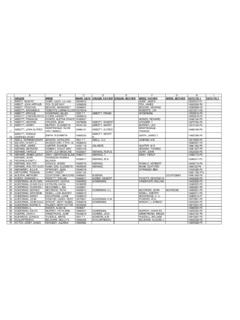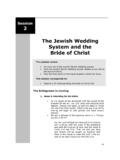Transcription of Grooming - casac index
1 Grooming . Grooming is a way of describing the actions a person deliberately does to try and befriend and make an emotional connection [often with a child] so they can hurt them. Grooming is a way of getting someone ready for abuse and involves tricks that offenders of sexual abuse use to manipulate their victim, the victim's family or community over time. This can be a very sneaky and slow process. Sometimes it is hard to see when someone is being groomed' until after they have been sexually abused, because some Grooming behaviour looks like normal . caring and nice behaviour. Children are often taught to "respect their elders". Sometimes if an adult does something that makes a child feel uncomfortable or upset, the child will ignore how they feel and go along with the behaviour because they believe that the adult is always right. Examples of Grooming include: Giving gifts or attention for inappropriate reasons Controlling a child through threats, force or use of authority Openly or pretending to accidentally expose the victim to nudity, sexual material and sexual acts Making close physical contact sexual, such as inappropriate tickling and wrestling Having an inappropriate and intrusive/pushy interest into children's physical and sexual development Having inappropriate social boundaries ( , telling the potential victims about their own personal problems etc).
2 RESPONSIBILITY. Many abusers refuse to accept responsibility for the abuse. Victims of the abuse can believe they are at fault for accepting gifts or trusting them. Victims can also feel responsible for what might happen to the people they love if they tell someone about the abuse or think that no-one will believe them. This can lead to the child/adult feeling responsible and then guilty, ashamed, full of self-blame and worthless. Abusers count on this to keep victims silent. The information below is especially relevant in cases where the abuser is a family member, care-giver or has some form of a relationship with the child and is from the New South Wales Pre-trial Diversion of Offenders Program (1994). Identifying and Targeting Offenders have a special ability to identify and take advantage of children's vulnerabilities. For example, offenders target a victim by sizing up the child's vulnerability emotional neediness, isolation and lower self-confidence.
3 Younger children are especially in danger as they do not have the language or knowledge to understand or tell others what is happening. Children who rely on the offender for care, love, affection or other things will be at risk to the demands of the abuser and children with less parental supervision are also wanted. casac Inc Fact Sheets: Grooming Recruitment [gaining trust]. Perpetrators gain trust by watching and gathering information about the person, getting to know their needs and how to fill them. This means that offenders mix effortlessly with responsible parents and carers because they seem warm, understanding and caring. The perpetrator uses different ways to keep the child in a relationship where the abuse can happen and to desensitise the child to abusive behaviour. Trust/Favouritism They will take deliberate steps to establish a relationship of trust, spending time with the child, listening to them, treating them as special , or perhaps giving them compliments/presents/favours- things the child really like and enjoy.
4 Isolation/Secrecy The perpetrator will isolate the child and keep them away from their siblings and from the non-offending parent. The favouritism shown to the victim often promotes alienation from siblings, and can cause resentment and jealousy. The perpetrator may use the child as a confidante , sharing special secrets. Statements like Mum wouldn't understand how special we are together , ours is a special love that others wouldn't understand contribute to a climate of secrecy and alienate the child from the non-offending parent. It means the child does not feel close to people in their family and this is called splitting'. Desensitisation A process of desensitisation is used to test the child's resistance and engage them in the abuse. Desensitising means to make someone NOT notice things or not worry about things when other people usually do. Perpetrators use normal situations and take advantage of these to hurt.
5 For example, they may use touching as a game or introduce sexual touching as accidental . They are likely to blur the boundaries of ordinary affection so the child confuses this with the abuse. This often occurs around the child's normal bathing, dressing and bedroom routines. The perpetrator may engage the child in their own bathroom behaviour or use talk about sex and sexual jokes to blur boundaries about it and make children confused. Throughout the process of trying to groom the child, the perpetrator is measuring whether the child has been groomed enough, for example whether they show interest, will not protest, or will keep the secret. Maintenance Perpetrators use careful planning, scheming and strategies to groom the child to participate in sexual activities. Bit by bit, they do things over time and keep checking the risks. The perpetrator will gain the compliance of the victim by: - Assuring the child of the rightness of what they are doing, through statements such as this is a way we can show we love each other , I am teaching you , it's not doing any harm.
6 - Telling the child the acts will not hurt them. - Conveying the negative consequences of non-compliance or disclosure, through threats, conveying the illusion that the child is free to choose, that he/she has consented and that they are in a relationship . casac Inc Fact Sheets: Grooming - Using bribes, threats, punishment Isolating the child The Grooming perpetrator uses the developing special relationship with the child to create situations in which they are alone together. This isolation further reinforces a special connection. Babysitting, tutoring, coaching and special trips all help this isolation happen. A special' relationship can be made stronger when the perpetrator gives a sense in the child that they are loved or appreciated in a way that others, not even parents, give. Parents may accidentally feed into this by really liking the perpetrator and appreciate the unique relationship or the time they are spending with their child.
7 Sexualizing the relationship At a stage when there is enough emotional dependence and trust, the perpetrator progressively sexualizes the relationship. Desensitization occurs through talking, pictures, even creating situations (like going swimming) in which both perpetrator and victim are naked. At that point, the adult exploits a child's natural curiosity, using feelings of stimulation to advance the sexuality of the relationship. When teaching a child, the Grooming perpetrator has the opportunity to shape the child's sexual preferences and can manipulate what a child finds exciting and extend the relationship in this way. The child comes to see himself as a more sexual being and to define the relationship with the perpetrator in more sexual and special terms. Maintaining control Once the sex abuse is occurring, perpetrators commonly use secrecy and blame to maintain the child's continued participation and silence mainly because the sexual activity may cause the child to feel yukky, scared or want to withdraw from the relationship.
8 Children in these entangled relationships and at this point they are entangled start to get threats which blame them, are told that the relationship might end and they won't get the emotional and material needs (the fun stuff) they associate with the relationship, whether it be the dirt bikes the child gets to ride, the coaching one receives, affection, special outings or other gifts. The child may feel that the loss of the relationship and the consequences of telling will humiliate and make them even more unwanted. SECRECY. The abuser makes the child keep the secret. This abuser can threaten to harm the child or others, tell the child that nobody will believe them, or tell the child that something bad will happen to them if they tell someone. This leads to the child/adult feeling isolated, confused, frightened and having to hide a large part of themselves and what happens.
9 PROTECTION AND LOYALTY. The abuser orders protection and loyalty from the child. Often the abuser is a trusted adult who the child loves, but they do not like the abuse. Sometimes the child wants the abuse to stop but doesn't necessarily want the abuser to be out of their life. This can leave them feeling very confused. casac Inc Fact Sheets: Grooming The perpetrator abuses his/her power over the child. This leads to the child/adult putting others first and self last. They are afraid to tell anyone and feel hopeless and powerless. Once the perpetrator begins to fill the child's needs, that adult might seem more important in the child's life and may become idealized (they can do no wrong). Gifts, extra attention, affection may make one adult in particular stand out and this should raise concern and greater vigilance. While people face similar struggles in the aftermath, it must be remembered that no two stories are the same and it is impossible to generalise the Grooming tactics of perpetrators.
10 But sometimes it can help when working through guilt and self-blame to have some idea of the same tricks of an abuser and how as a child you were the victim of a targeted and planned attack. What happened was not your fault and despite the messages you may have been given as a child and the words that were said to you, it is important to remember one thing: It's not your fault. ASCA HEALTH WA casac Inc Fact Sheets: Grooming






